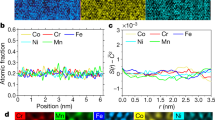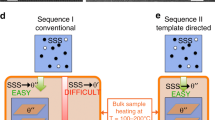Abstract
PRELIMINARY results from an X-ray study of the peritectic reaction + liquid in the Cu-Zn system prove that the orientations assumed by the -phase are definitely related to the orientation of the -phase. Specimens suitable for accurate orientation studies (by means of back-reflection Laue patterns) were prepared by solidifying a pure -alloy (52 per cent copper) under a uniform temperature gradient, and seeding the crystallisation with a copper single crystal. The resulting specimens then consist (in order, from bottom to top) of (a) copper crystal seed, (b) primary crystallised -phase having the same orientation as the copper seed, (c) large -grains (2–5 mm.), the nuclei of which originated in the peritectic reaction +liquid; these -grains have a narrow rim of segregated -phase. This sequence of crystallisation is made possible, as was expected, by the diffusion of copper into the liquid -brass adjacent to the solid copper crystal.
This is a preview of subscription content, access via your institution
Access options
Subscribe to this journal
Receive 51 print issues and online access
$199.00 per year
only $3.90 per issue
Buy this article
- Purchase on Springer Link
- Instant access to full article PDF
Prices may be subject to local taxes which are calculated during checkout
Similar content being viewed by others
References
Sci. Rep. Tôhoku Imp. Univ., iv, 23, 637 (1934).
Mitt. Kaiser-Wilh.-Inst. Eisenforsch., 17, 149 (1935).
Author information
Authors and Affiliations
Rights and permissions
About this article
Cite this article
GRENINGER, A. Orientation in Peritectic Structures. Nature 137, 657–658 (1936). https://doi.org/10.1038/137657b0
Issue Date:
DOI: https://doi.org/10.1038/137657b0
This article is cited by
-
Review of Grain Refinement of Cast Metals Through Inoculation: Theories and Developments
Metallurgical and Materials Transactions A (2017)
Comments
By submitting a comment you agree to abide by our Terms and Community Guidelines. If you find something abusive or that does not comply with our terms or guidelines please flag it as inappropriate.



